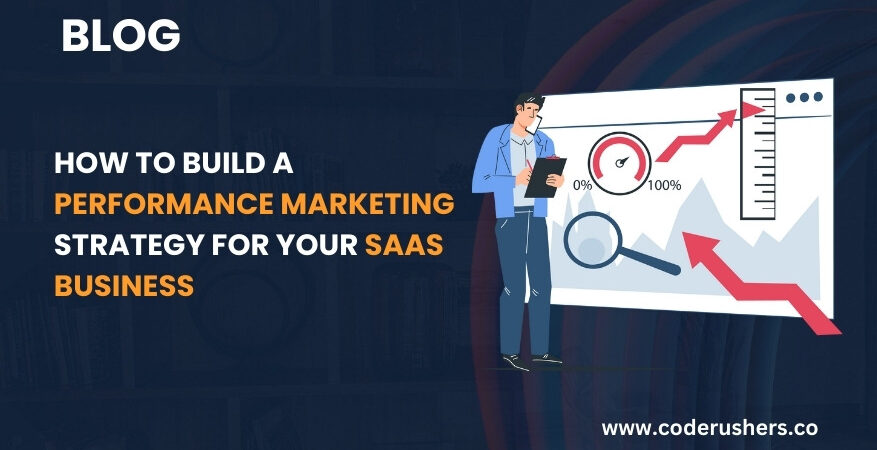Too many SaaS companies are stuck in the click-chasing cycle. They see traffic and think they’ve “made it,” only to find their CAC creeping up and their LTV barely moving. The key to growth lies in performance marketing for SaaS that’s simple, focused, and tailored to what your business truly needs.
Did you know that 64% of marketers say performance marketing directly improved their ROI? And for SaaS, a small increase in customer retention can lead to big profit gains, up to 25% more.
So, what’s the secret? It’s about tracking the right numbers, understanding your customers, and making smarter choices at every stage. In this guide, I’ll show you exactly how to build a performance marketing strategy that helps in your SaaS growth, without wasting money. Let’s get started.
Why Performance Marketing Matters for SaaS Businesses?

Performance marketing is all about getting measurable results, and when you use it for SaaS businesses, that becomes a game-changer.
Unlike traditional marketing, where you measure success based on how many people saw your ad or heard about your product, performance marketing for software is much more action-driven. It’s about things that matter, like getting sign-ups, converting free trials into paid customers, and ultimately, growing a loyal customer base.
When it comes to performance marketing for SaaS, the goal isn’t just to get a bunch of clicks. You need to make your SaaS products meaningful to them so that they stick with you as long-term users. That means every dollar you spend on ads, every campaign you run, and every strategy you use should be focused on driving meaningful outcomes that contribute
to the bigger picture: growing your customer base and increasing their lifetime value.
Step By Step Guide to Effective Performance Marketing For Software
This step-by-step guide is for SaaS founders and marketers who want to go beyond the basics, and start using SaaS marketing strategies that bring real, measurable results:
Step 1: Utilize Actionable Data
Gone are the days when SaaS marketers had to guess what would work. In 2025, performance marketing for SaaS will be rooted in real-time analytics to keep you ahead of the curve. By focusing on data-driven strategies of performance marketing, you can stop wasting resources and start investing in what’s truly working.
- Track where your most engaged customers are coming from by using tools like Google Analytics 4 or Mixpanel. Which keywords bring the best results? If you’re spending money on Google Ads, are you bidding on terms that your best customers are actually searching for?
- Fine-tune your SaaS customer acquisition approach by using platforms like Facebook’s Lookalike Audiences or LinkedIn Matched Audiences. They segment your audience into smaller groups based on behaviors, demographics, and firmographics.
Step 2: Optimizing SaaS Marketing Campaigns for Customers

The customer journey in SaaS isn’t a straight line, it’s a winding path where potential customers will explore your product, sign up for a free trial, but then drift away. That’s why lead nurturing for SaaS is really important before converting. The key to software marketing is to offer value and build trust at every stage:
- Gone are the days when you tell users how to use your software. It’s time to make them feel like your product was designed specifically for their needs. Create a high-class onboarding experience through email drip campaigns, personalized tutorials, or in-app tips. This type of subscription marketing experience is crucial for turning trials into paid subscribers.
- Remember, not all users will convert after one trial, but consistent nurturing can turn those initial signups into loyal, paying customers. Build strong relationships through regular, value-driven communication. Use a combination of email sequences, educational webinars, and retargeting ads to keep users engaged and remind them of your product’s value.
Step 3: Invest in the Right Marketing Tools
If you’re serious about growth, you need the right performance marketing automation tools to analyze and optimize your performance marketing for Saas. It’s no longer enough to monitor basic metrics like clicks and impressions. You have to go deeper.
- Dynamic Creative Optimization (DCO): Platforms like Google Ads and Facebook now allow you to dynamically test multiple ad variations, like headlines, images, and CTAs. These tools will automatically optimize the best-performing combinations, saving you time and money while improving performance.
- Conversion Rate Optimization (CRO): Tools like Optimizely or VWO allow you to test different landing pages, CTAs, and even messaging. By continuously tweaking and testing, you can improve your Saas conversion rate over time.
Step 4: Retarget for Higher Conversions
In this crowded market, most people don’t buy SaaS products after their first interaction. But retargeting allows you to stay in front of them and remind them of the value your SaaS offers. This can significantly improve conversion rates over time.
- Dynamic retargeting: Show personalized ads based on the pages a user has visited or the features they’ve engaged with. This creates a more relevant and compelling offer.
- Cross-platform retargeting: Users are hopping between devices and platforms all the time (from Facebook to Google to LinkedIn) ensures that you’re staying top of mind no matter where they go.
Step 5: Focus on Customer Retention and LTV

Once you’ve turned leads into paying customers, your focus should shift toward maximizing lifetime value (LTV). To achieve this, Customer retention strategies are essential for SaaS businesses because retaining existing customers is often more cost-effective than acquiring new ones.
- Keep your customers engaged by offering consistent updates, new features, and valuable content. If they feel like they’re getting more than what they signed up for, they’re less likely to churn.
- Use surveys, Net Promoter Scores (NPS), and other tools to gather customer feedback. Act on it to improve the user experience and increase satisfaction.
Pro Tip: The longer you can retain a customer, the more profitable they become. Focus on long-term relationships instead of quick wins.
Step 6: Upselling and Cross-Selling for More Revenue
A successful SaaS marketing strategy doesn’t just focus on acquisition, it also focuses on maximizing the revenue from current customers through upselling and cross-selling.
- Upselling: As customers grow with your product, they may need more advanced features or higher-tier plans. Make sure you’re offering them the tools they need to expand their usage.
- Cross-selling: If you offer multiple products or services, cross-selling is a great way to increase the average revenue per user (ARPU). Offer complementary products that enhance their experience.
Step 7: Keep Optimizing and Refining Your Strategy
The beauty of performance marketing is that it’s an ongoing process. You should always analyze and refine your campaigns. Track everything, from clicks to conversions, and use that data to improve your SaaS growth.
- A/B testing: Constantly test different aspects of your campaigns—ads, landing pages, offers. See what works best and double down on those efforts.
- Monitor your metrics: Keep an eye on your CAC, LTV, conversion rates, and other KPIs. Adjust your campaigns accordingly to ensure you’re getting the best return on your investment.
Final Thoughts!
In 2025, performance marketing for SaaS business isn’t about using the latest trends just because they’re trendy. Focus on the whole customer journey, from attracting high-intent users to keeping them engaged long after they’ve signed up. Use the latest marketing tech, invest in customer retention, and above all, ensure that data backs every action you take.
In the end, the SaaS businesses that succeed in 2025 are those that don’t just chase growth, they build it, measure it, and optimize it, every single day.
At Code Rushers, UAE we help SaaS companies optimize every marketing dollar for maximum impact. Ready to accelerate your growth? Contact us now!
Frequently Asked Questions
A data-driven strategy focused on measurable results like customer acquisition, conversions, and ROI through digital marketing channels.
A/B test ad creatives, use dynamic creative optimization (DCO), segment audiences, and refine messaging based on real-time analytics.
Google Ads, LinkedIn Ads, Facebook Ads, SEO, and email automation are the most effective for lead generation and customer acquisition.
Refine targeting, optimize ad creatives, improve landing pages, leverage retargeting, and nurture leads with automated email sequences.
Focusing too much on new customer acquisition while neglecting retention, churn reduction, and optimizing the customer journey.

